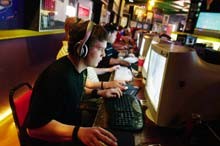Men and boys dream of cash and glory at two weekend LAN tournaments
| Jason Avery from Longview, along with other members of Team Kaos, takes on rival teams in a five-on-five tournament for the game "Counter Strike: Source" at SA-Fragfest '05. |
"Man, who made us play these guys first?" Bullard complains. "We're getting destroyed!"
Bullard is not really in Mexico, nor is he a terrorist. It is a sunny Saturday in San Antonio, and Bullard has united with about 25 other "gamers" in a dark, dingy sports bar to collectively plug into a video game known as "Counter Strike: Source." The players have lugged their personal computers from various corners of Texas and are now wired to a LAN, a local area network, which enables a select conclave of computers to communicate with one another. This is a tournament. Teams of five, known as "clans," seek the bloody annihilation of their enemies for the grand prize: $500.
"They love it," says David Teniente, a member of the Hooked On Phonix clan, which sponsored this LAN. "But if you watch them over time, you'll see the stress, the wear and tear. You'll see the frustration."
"What the fuck!" spews one rotund gamer, dismayed at having met his temporary demise.
"Please cover me!" yells his teammate.
"One behind me! One behind me! Outside!" screams another with rising panic. Across the room, a more sedate gamer informs his team, "I just threw a hand grenade at myself," and laughs.
Most of the entrants at this tournament are post-adolescent males, although a few have not yet reached their teens, and others, like Bullard, are middle-aged. Today, there is a general indulgence in nicotine; the entire room seems to buzz with instant gratification, whether culled from a cigarette or the prompt dispatch of a digital enemy.
"It's not real," says Matt Nunnelly, a gangly 17-year-old with shoulder-length curls, of the virtual violence that permeates the room. "I keep reading more and more of these stories that connect video-game violence to real violence, and it seems like a scapegoat to me." His friend, Chris Cardenas, agrees. "It's not really the killing that makes it fun, it's the competition."
The competition can sometimes swell to colossal proportions. Cardenas estimates there are 2 million "Counter Strike" gamers worldwide. The best compete in the CPL, the Cyberathlete Professional League, which is based in Dallas and draws players from around the world. Last summer's world championship attracted 4,000 gamers and dispensed $275,000 in cash prizes. Some make their living this way. Nunnelly speaks reverently of a renowned clan called "Team 3-D," consisting of players who earn their keep entirely on the proceeds from corporate sponsorship and their exquisite gaming skills.
Jeremy Pacheco is a 17-year-old gamer who plans to live off his thumbs. Right now he is standing in Cyber World, a hollowed-out bank turned gaming center that is hosting a tournament the same day as Hooked on Phonix's event, this time for the immensely popular X-BOX game "Halo 2." Along with Pacheco, clans of teenage boys linger expectantly, all of them yearning to take up their plasma pistols and make some kills. A thick swath of dyed-blond hair covers Pacheco's face like a curtain, leaving just enough space for one eye, and two silver studs protrude beneath his lower lip. He has taken extreme measures to cultivate his gaming ambitions.
"I started taking home school so I could play 'Halo' more often," Pacheco says. He insists his parents condoned this measure. "I had a problem going to school anyway."
A fellow clan member offers a simple explanation. With the rapt gleam of a junkie's eye, he says, "It's really addicting." •
















